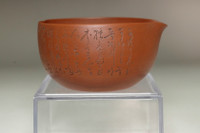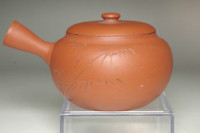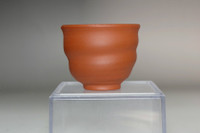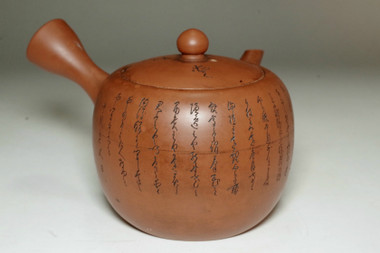 Loading... Please wait...
Loading... Please wait...Currency Displayed in
- Home
- SOLD ITEMS
- Yamada Jozan III (1924-2005) Vintage tea pot in tokoname ware #3904
Categories
Yamada Jozan III (1924-2005) Vintage tea pot in tokoname ware #3904 for sale
Product Description
Up for sale is this "Yamada Jozan III (1924-2005) Vintage tea pot in tokoname ware #3904" If you have any questions please contact us before buy it. No reserve.
- width: approx. 15cm (5 29⁄32in)
- height: approx. 10cm (3 15⁄16in)
- weight: 211g
- condition: damaged
Yamada Jozan III (1924-2005)
Born the eldest son of the second generation Yamada Jozan, he studied under his father and grandfather, who was the first generation Jozan, while attending school, in order to inherit the family business.
In 1947, after the death of the first generation, his father succeeded the name as Jozan, and Minoru took on the name his father used to have, Kojozan.
In 1958, he was chosen for a prize for the first time in the Fifth Japan Traditional Kogei Exhibition, and he received the Grand Prix at the Brussels International Exposition in the same year. After receiving awards such as the First Class Asahi Prize in the Seventh Daily Life Kogei Exhibition in 1959, he was inaugurated as a full member of the Japan Kogei Association in 1962.
In addition, he succeeded the name as the third generation Yamada Jozan from 1961, following the death of his father.
The 1970s became an opportunity for him to be rated highly on an international scale, such as displaying his work in the Osaka International Exposition in 1970 and in the Third Biennale International Ceramics Exhibition in 1973 (received the Honorary Top Grand Prize.)
He also started the Tokoname "Handcrafting Teapots Society" with other local pottery artists to hand over traditional Tokoname ware, assuming office as the society's president.
Not content with tradition, he continued his research day by day, such as completing his original technique of firing a teapot with its lid still on with an old Tokoname anagama kiln, and then pouring natural glaze on top as it is. In 1994, he was acknowledged as an Aichi Prefectural Designated Preserver of Intangible Cultural Property, and he went on to be acknowledged as a Nationally Designated Important Intangible Cultural Property (Living National Treasure) in 1998.
He excelled in the technique of producing teapots (mainly the type used for sencha tea) to the point that it is said that Tokoname shudei pottery is equatable to Yamada Jozan. He produced a wide range of works, from classical pieces to innovative works aligned with modern purposes, and it is said that there are over 100 designs that served as prototypes.
In addition, apart from teapot works, he has also left remarkable pieces such as sake cups, pots and large bowls.
Tokoname ware
The Tokoname kiln has the longest history and had the largest production area among Japan's six old kilns (Tokoname, Shigaraki, Bizen, Tamba, Echizen, Seto). Its beginning dates back to the late Heian period (approx. 1100 AD), and an estimated 3000 Anagama kilns (tunnel kilns) were built in the hilly areas of the the Chita Peninsula in the Aichi Prefecture, centered at Tokoname City. Tsubo (jars), Kame (wide-mouthed bowls), and Yamajawan (mountain tea bowls) were made using these kilns. Tokoname wares made during the Heian period up to the early Edo period are referred to as "Old Tokoname."
During the latter part of the Edo period up to the Meiji period, the adoption of China's Shudei (unglazed reddish brown pottery) and European techniques led to a rapid increase in the production of Tokoname wares. "Tokoname Ware" refers to earthenwares made since ancient times in the Aichi Prefecture, centered at Tokoname. It is still a firm favorite.
In the past, there used to be huge lakes in Aichi, Mie and Gifu prefectures including Tokoname. This lake, called Lake Tokai, was a larger lake than the current Lake Biwa. The production areas of Tokoname ware, Shigaraki ware, and Iga ware were once in this lake.
Originally, Tokoname-ware was famous for its red stoneware, which had excellent performance in the taste of the tea. Tokoname's vermilion stoneware spread among people who like tea because the taste of tea becomes mild with it.
Tokoname's vermilion stoneware was started by a person named Sugie Jumon (1827-1897). At first, the stoneware was developed from the desire to make a good teapot like Yixing China on Japanese vermilion mud. For this reason, many of the teapots made by Sugiei were made by imitating Yixing teapots, and of course, Sugie himself understood the goodness of Yixing natural vermilion mud. In Tokoname at that time, the teapots were baked using Tokomame’s natural vermilion mud, and its quality was very high.
Unfortunately, now cheap teapots made from a mixture of red‐ocher rouge and vermilion mud have become mainstream. It looks bright and beautiful in vermilion, but if you want a teapot that improves the taste of tea, like a teapot made of natural vermilion mud, you have to buy expensive items or vintage items.
(Note) "vermillion mud" refers to the soil that changes to vermillion from ocher when oxidized and fired with the singular exception of Mumyoi. The soil of Mumyoi ware is vermilion before oxidized and fired.
shop policy
AppraisalWe appraise our items using various resources. If you feel that a purchased item differs from your expectations, please inform us. We respect your opinion.
Cancellation and Return
We accept return only if you contact us within 30 days after you receive the items. Return-shipping costs are the buyer’s responsibility. If you ask a cancellation before shipping the package, we may ask a 20% restocking fee.
Shipping
+ Shipping to the USA, Europe, and Asia is free. For other areas, please contact us. Shipping is via EMS or DHL.
+ VAT is not included in the item price.
+ We will ship within 3 business days. Shipping time is usually around a week.
Insurance
We are not responsible for delays, returns, damage or loss due to customs or postal processing. EMS is insured (the amount on the label is the guaranteed amount). If you choose DHL, we recommend that you purchase additional insurance. Please note that if you choose the DHL drop service option, insurance will not be applied.
Taxes
Import duties, taxes and fees are not included in the item price. If your country requires customs duties, etc., it is your responsibility to pay them.
To customers buying tableware
Our products are mostly used. We sell them in the same condition they were purchased, please be sure to clean them thoroughly before actually using them.

























